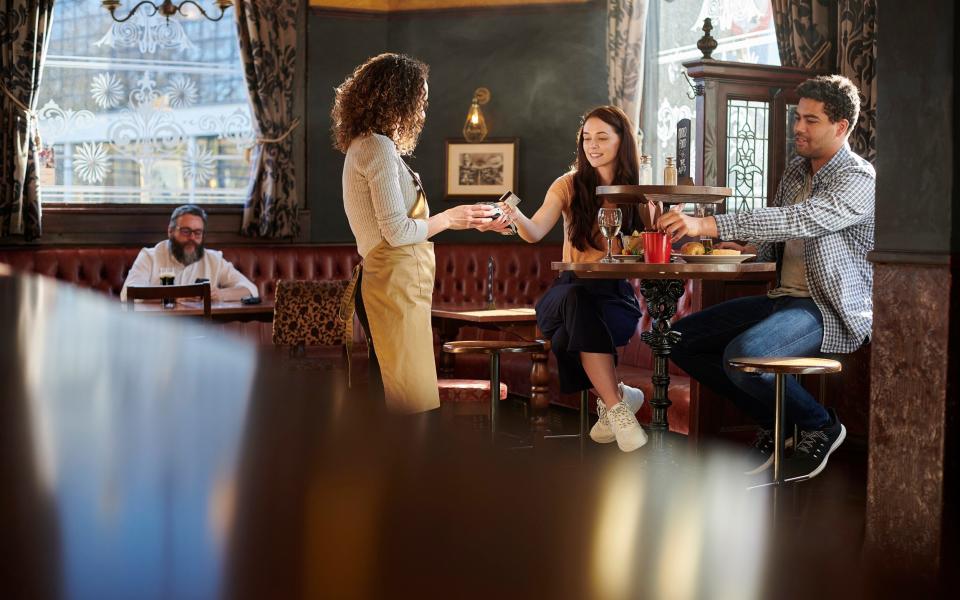“When you buy an iPhone for £1,000, you assume that Apple has covered its staff costs,” quips restaurateur Richard Crampton-Platt. “You don’t look at the receipt and see an additional ‘service charge’.”
It’s ridiculous to even imagine such a thing, but that’s exactly what happens every time we go to a restaurant or bar.
We get a bill listing everything we’ve eaten and drunk, and then we have to pay an additional amount – either a ‘discretionary’ percentage calculated for our convenience at the bottom of the bill, or customary if it’s not shown on the bill. The idea is that this amount goes to the staff, and most of us comply. Some even reach into their pockets and pay much more than the traditional 10% to 12.5%.
But a recent survey of 2,000 consumers found that 22 per cent of respondents never pay for the service and attitudes vary regionally, with 34 per cent of respondents in the South West avoiding paying, while in Yorkshire around 30 per cent of respondents avoid paying tax.
In many ways, this is no surprise. The service charge has been rising steadily for years. First 10%, then 12%, then 12.5%. In some places, it has reached 15% to 17%. It’s understandable why diners are starting to question this.
But the flip side of this is that most consumers, even in Yorkshire, are not above paying. As Kate Nicholls, chief executive of UK Hospitality, puts it, “these figures show that the overwhelming majority of consumers are more than happy to pay a service charge to reward hard-working hospitality staff.”
Most restaurant owners I know can count on one hand the number of people who refuse to pay a service charge; often they will simply withdraw the charge themselves if they feel their service is substandard.
Click here to view this content.
So why all the fuss? This survey has highlighted the confusion and debate surrounding service charges in the UK and how they work. Unlike Americans, who pay 20% as the norm, many Brits are less comfortable doing so.
But while restaurants were closed during the lockdown, it emerged that many furloughed staff were earning less than minimum wage – because the ‘optional’ service charge was used to keep wages reasonable and stable.
“The public perception and ideal is that this is a ‘thank you’ added on top of the bill and therefore optional. [even when it is added as standard]“This is a great way to build a community and recruitment platform for hospitality workers,” says Kitty Slydell-Cooper, head of communications at Countertalk.
“The reality is that most – in fact, almost all – restaurants use this to raise wages to a reasonable salary, and if customers try to skimp by removing the fee, the hard-working people providing their meals will not be paid enough.”
This practice sounds ridiculous until you understand how service fees work.

“You don’t pay national insurance on it and you don’t pay VAT – so it’s a tax break,” says Crampton-Platt, who opened Café Britaly in Peckham, south-east London, earlier this year. For his part, he’d rather the whole thing be cancelled and restaurants run like Apple (and every other company outside the hospitality sector).
“It would have been better for everyone if this had been added to the bill,” he explains – but the customer’s bill would have increased significantly.
The lack of tax means a lack of transparency about how service is calculated and where it goes. Some restaurants use tronc, a system where a service charge is collected and distributed equally across all staff members based on hours worked. “We have a tronc system that works really well to incentivise the whole team – front office, kitchen and housekeeping,” says George Pell of The Suffolk in Aldeburgh.
Service charges are 10% and are not automatically added, so the customer feels more empowered and doesn’t have to deal with the awkwardness of asking for it to be removed. Some restaurants use an app called Tip Jar, which takes the tipping task out of the restaurant’s hands; some keep a fair percentage of tips during good times like December, increasing rates during quieter months. It’s rare for a restaurant to have the audacity to not give it to staff at all.
It’s easy to see why customers are confused about the legitimacy of the service charge, with 47% wanting to be able to decide for themselves whether to pay it and 19% agreeing with Crampton-Pratt that it should be removed and included in menu prices. Furthermore, there are regional differences over whether it is included, which may explain why Londoners are more willing to pay it.
“There’s a noticeable difference in attitudes to the service charge outside London. In Suffolk it’s rare to see it automatically added to your bill,” says Pell, who worked at L’Escargot in Soho before The Suffolk.
New legislation, which will come into force in October, will make it legally binding for all service fees to be paid directly to staff each month.
“If this trend continues, hospitality workers, who stand to earn more when the new tipping law comes into effect on 1 October, could see their earnings fall short of expectations as some consumers are reluctant to tip or pay a service charge for exceptional service,” says Saxon Mosely, head of leisure and hospitality at RSM UK.
For Slydell-Cooper and Crampton-Platt, the law simply kicks the issue into the long grass. “There’s no other industry that pays its workers this way, and frankly, it’s not fit for purpose,” Slydell-Cooper says matter-of-factly.
I have never come across anyone in the 22% who does not pay a service fee; I have only found those who do when they encounter truly terrible service.
“I had one taken out at Balans once,” says journalist Sian Meades-Williams. “The manager got really angry with me because we had been there as a group for so long. I had to explain that we still hadn’t eaten anything.”